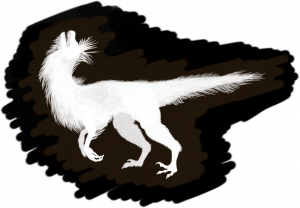This is an old revision of the document!
Table of Contents
The kavkema are a (largely nocturnal) species descended from Earth's dromaeosaurids. As a culture, they try to avoid any form of prolonged suffering and prefer swift, painless deaths over it if the choice must be made. As such, they are cowed into passivity by the Nayabaru, whom they chiefly try to desperately avoid given what's likely to happen to them if they're caught.
They're a minority on Nekenalos, to the point where Threadwielders other than Evenatra occasionally dismiss them as extinct - after all, give a few millennia, and they will be.
Habitat
The kavkema have moved from the original dromaeosaurid habitats of grasslands up into mountainous regions, where their feathery coat allows them to keep in heat and they're reasonably far away from the areas the Nayabaru would find naturally appealing. As such, they are accustomed to seeing snow despite it being an oddity on Nekenalos as a whole due to the planet's climate.
Biology
In captivity, kavkema may get as old as 40 years, assuming they are treated well (the kind of captivity in the Pens tends to reduce their lifespan, not raise it - 40 year old kavkema tend to be pets). In the 'wild', they often die before they are 25, though cases of 30-year old wild kavkema are known.
Reproduction
Typically, they are superprecocial once they hatch (after six weeks of growth in the egg), though if left to their own they certainly will only ever be a wild animal. To save them from the very specific dangers of Nekenalos and to educate them in language, religion and potential sciences, they require parental protection at least until they are one year old (at which point they may have learnt as many as two languages and many practical survival tips), and usually stay with their parents for up to four years, circumstances permitting.
Colouration
Owing to their habitat, kavkema are largely brown and white in colouration, though albinism is barely selected against (the sole trouble with that is the resulting hypersensitivity of the eyes, but for a nocturnal species this only makes some nights troublesome) and the albino population is thus reasonably significant. Their irides are brown with little variation and their eyes have no pronounced, expressive whites. While a roughly 50/50 ratio of browns and whites in their overall appearance is normal, the range does go from 90/10 brown/white all the way to 30/70 brown/white (in non-albinistic individuals).
Courtesy
Courtesy amongst kavkema can be compared to courtesy amongst social pack animals of Earth: A significantly lowered muzzle denotes subservience, an upturned belly moreso. It is customary amongst kavkema, regardless of social status, to dip their muzzle to the ground in greeting, although the tip of it does not need to outright touch the ground (though in particularly enthused greetings, this will be done). Similarly, it is courteous to be facing each other at all times, and it can cause quite some distress if a kavkem is approached from behind or even just the side, and is generally viewed as an act of aggression.
Reaction to Fear
The reaction to stressful situations in kavkema is rather simple: When presented with the option to flee, they do, regardless how well-equipped they may be to fight, unless close family (especially juvenile family) is threatened in the process.
As a rule, female kavkema are significantly better fighters than male kavkema, and thus slightly less prone to flight than their male counterparts.

